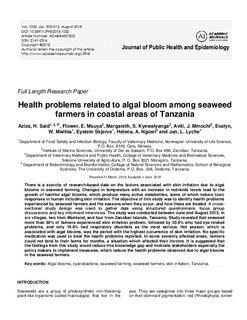| dc.contributor.author | Said, Aziza H. | |
| dc.contributor.author | Kyewalyanga, Margareth S. | |
| dc.contributor.author | Msuya, Flower E. | |
| dc.contributor.author | Mmochi, Aviti John | |
| dc.contributor.author | Mwihia, Evalyn W. | |
| dc.contributor.author | Skjerve, Eystein | |
| dc.contributor.author | Ngowi, Helena | |
| dc.contributor.author | Lyche, Jan Ludvig | |
| dc.date.accessioned | 2019-09-04T09:46:02Z | |
| dc.date.available | 2019-09-04T09:46:02Z | |
| dc.date.created | 2019-09-02T14:21:12Z | |
| dc.date.issued | 2018 | |
| dc.identifier.citation | Journal of Public Health and Epidemiology. 2018, 10 (8), 303-312. | nb_NO |
| dc.identifier.issn | 2141-2316 | |
| dc.identifier.uri | http://hdl.handle.net/11250/2612421 | |
| dc.description.abstract | There is a scarcity of research-based data on the factors associated with skin irritation due to algal blooms in seaweed farming. Changes in temperature with an increase in nutrients levels lead to the growth of harmful algal blooms, which produce many active metabolites, some of which induce toxic responses in human including skin irritation. The objective of this study was to identify health problems experienced by seaweed farmers and the seasons when they occur, and how these are treated. A cross-sectional study design was used to gather data using structured questionnaire, focus group discussions and key informant interviews. The study was conducted between June and August 2015, in six villages, two from Mainland, and four from Zanzibar Islands, Tanzania. Study revealed that seaweed more than 50% of farmers experienced skin irritation problem, followed by 30.4% who had eye related problems, and only 19.6% had respiratory disorders as the most serious. Hot season, which is associated with algal blooms, was the period with the highest occurrence of skin irritation. No specific medication was used to treat the health problems reported. In some severely affected areas, farmers could not tend to their farms for months, a situation which affected their income. It is suggested that the findings from this study would reduce this knowledge gap and motivate stakeholders especially the policy makers to implement measures, which reduce the health problems observed due to algal blooms in the seaweed farmers. | nb_NO |
| dc.language.iso | eng | nb_NO |
| dc.rights | Attribution-NonCommercial-NoDerivatives 4.0 Internasjonal | * |
| dc.rights.uri | http://creativecommons.org/licenses/by-nc-nd/4.0/deed.no | * |
| dc.title | Health problems related to algal bloom among seaweed farmers in coastal areas of Tanzania | nb_NO |
| dc.type | Journal article | nb_NO |
| dc.description.version | publishedVersion | nb_NO |
| dc.source.pagenumber | 303-312 | nb_NO |
| dc.source.volume | 10 | nb_NO |
| dc.source.journal | Journal of Public Health and Epidemiology | nb_NO |
| dc.source.issue | 8 | nb_NO |
| dc.identifier.doi | 10.5897/JPHE2018.1020 | |
| dc.identifier.cristin | 1720642 | |
| cristin.unitcode | 192,16,2,0 | |
| cristin.unitname | Institutt for mattrygghet og infeksjonsbiologi | |
| cristin.ispublished | true | |
| cristin.fulltext | original | |
| cristin.qualitycode | 0 | |

